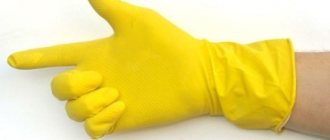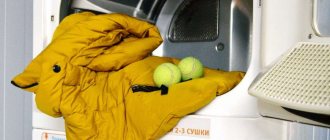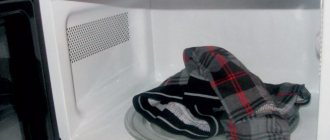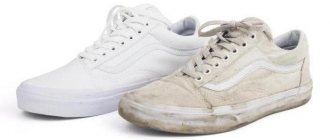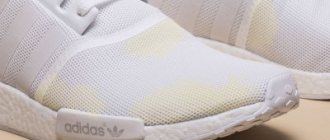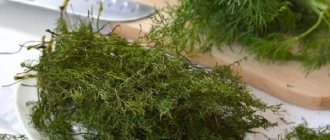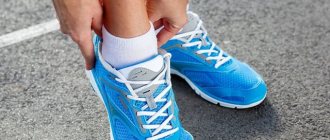You can extend the life of your sneakers with careful care. Proper washing of sneakers, and equally important competent drying, help preserve the appearance, shape, and color of sports shoes for as long as possible.
Is it possible to place wet sneakers on a radiator? How to dry leather shoes correctly? What to do if your white sneakers get wet?
The answers to these and many other questions will be useful for those who do not know how to quickly and correctly dry sneakers after washing.
Features for different materials
The method for drying sneakers after washing largely depends on what type of material they are made from:
Textile sneakers, lightweight fabric sneakers or sports shoes can be dried using a stream of warm air generated by a hairdryer or fan, or a regular crumpled newspaper. The process can be significantly speeded up by special equipment designed for drying shoes - electric dryers.
Sneakers made of genuine leather should absolutely not be dried with a directed flow of high-temperature air, and when using electric dryers, it is recommended to lubricate the surface of the shoes with a special protective compound. This will help protect the material from drying out and cracking.
Suede shoes can be dried using only delicate drying methods using crumpled newspapers or silica gel. Drying should be carried out away from heating devices at room temperature.
Common mistakes
Often there is very little time left to dry your favorite pair. I want to get results as quickly as possible, and because of this, some mistakes are made. Without knowing why you can’t dry shoes on a radiator, you can ruin shoes or boots made of any materials.
You should not dry your boots on a heating radiator for the same reason as other shoes. High temperature not only removes moisture, but also damages the outer layer. After this, the leather and suede may crack. You should also not use other heating devices:
- oven, not only for hygiene reasons, but also because you can “cook” shoes that are not intended for a high temperature range;
- oven, since the sole, which will be heated the most, may fall off;
- electric heater.
High temperatures that are not designed to interact with shoes can ruin the appearance and deform the products, so it is extremely important to choose an option that is suitable for the range. Wet shoes only at first glance seem like an insoluble problem.
Armed with knowledge, you can easily solve the problem and quickly dry your shoes without harm or loss of time.
Preliminary preparation
Before washing and drying sneakers, you need to prepare them first. Remove visible dirt by washing it off with a sponge and soapy water, or wiping it with a napkin.
Then you need to remove the laces, insole and other accessories. Shoes need to be opened as much as possible - this will speed up the process of moisture evaporation. Explore the capabilities of your washing machine. For example, in Kandy, there are special programs for washing sports shoes.
What can't you do?
What do we immediately think about when we need to dry wet boots? About hot batteries! After all, this is how you can completely dry your shoes in a couple of hours. And this is a big mistake.
Remember: never put wet steam on the battery! This is how you will ruin it the fastest. There will be streaks on the shoes, and the soles may come off. High temperatures are harmful to any coating except rubber. If you haven't ruined a pair of boots this way yet, then you're just lucky.
If your shoes get wet, be prepared for the fact that it will take a long time to dry - the whole night, and sometimes even more.
It is very important to dry correctly. Warm air is one option, but there should be no direct contact with it
Drying boots or shoes is necessary in a well-ventilated room, or better yet, on a balcony or street.
Quick drying methods
How to dry sneakers after washing using newspapers
One of the old, but nevertheless effective methods is drying sneakers using newspapers. Wet sneakers are filled with crumpled paper sheets, which quickly absorb moisture.
That is why during the drying process the paper should be replaced with fresh one every two hours.
Drying sneakers with a fan or air conditioner
In order to dry steam using this method, it is necessary to modify the device by attaching wire hooks to its mesh. This is where you should hang wet sneakers or sneakers. A few hours of operation of the device and the sneakers will become dry. Drying with air conditioning follows the same principle.
How to dry sneakers using rice, salt, soda
With rice
In order to quickly dry your sneakers after washing with rice, you can use two methods.
Place the wet sneakers in the box, first turning them over, then pouring rice on top. The lid of the box must be closed and left to dry for 5-6 hours. The cereal will absorb moisture, and after some time you can take completely dry shoes out of the box.
The second option: pour rice into socks, which are subsequently placed inside sneakers or sneakers. It is recommended to leave the sneakers in this position overnight.
Soda
How to quickly dry sneakers at home? Use a product that is in every home, baking soda. For drying, cloth bags are filled with soda and placed in sneakers. As the filler dries, it should be replaced with a dry one. After complete drying, the couple should be ventilated.
Salt
You can dry wet shoes quite quickly using regular salt. For this:
- Salt is poured into a frying pan or plate and heated over a fire or in the microwave.
- Place it in a bag made of thin fabric (or gauze).
- Place it inside the shoe.
Useful tips
To enjoy your favorite sneakers for as long as possible, you need to provide them with quality care.
Shoe sewing experts advise regularly washing and laundering sports pairs, while following the established rules:
- Dry the sneakers away from open fire or a source of excessively high temperature (heater, oven or central heating radiator).
- Do not tumble dry.
- Before processing, you need to remove the insoles and remove the laces. They absorb excess moisture.
- Thoroughly remove any dirt before washing.
- Using newspapers and paper, change them every 30 minutes.
- Drying with rice allows you to avoid filling your shoes with grains. It is enough to pour rice into some container and place a sports pair on top of it with the sole of the shoe.
Compliance with generally accepted rules will guarantee high-quality drying, and as a result - clean, dry sneakers that have retained their original shape and attractiveness.
When playing sports in any weather, going on a hike or for a walk, you should know that you need to dry your sneakers and sneakers immediately after being indoors. Products made from natural and artificial leather can only be preserved if you take care to maintain their shape and avoid strong heat.
What kind of shoe dryers are there on the market today?
Standard dryer
The standard electric dryer is a heated mat or shelf. This dryer takes up little space, gently dries shoes, and can accommodate the shoes of all family members at the same time.
How long it takes for sneakers to dry after washing during use depends on the type of shoe and the material from which it is made. On average from 4 to 12 hours.
Paper
Even in early childhood, many became acquainted with this method, when, coming home after playing in the snow or “swimming” in the rain, they could at least wring out their shoes. Then the parents did not skimp on comments, at the same time stuffing shoes or boots with old newspapers. Now this method is also used quite often. But you should remember that you should not stuff paper into shoes too tightly, otherwise there is a risk of changing its original shape. Another nuance is that it is better to take colorless paper, such as toilet paper or regular white paper, since newspapers may leave traces of printing ink on light-colored shoes.
How to properly dry wet sneakers after washing. Scheme for drying wet shoes
In order to dry wet sneakers correctly, you need to:
- If you get caught in the rain, immediately remove your wet shoes as soon as you come from the street.
- Remove adhering dirt from the surface.
- Unlace the sneakers and remove the accessories.
Make sure that wet shoes are not exposed to heating devices. Otherwise, the material may become deformed.
When your sneakers get wet
Running shoes are usually used in a very active mode. This includes sports and regular walks. When putting on sneakers, people often stop caring about small puddles on the path, wet grass or liquid mud underfoot.
This is especially true for children and youth. It is not surprising that such use risks sneakers quickly getting wet. This can also happen from sweat. Active movement and tight fitting shoes tend to get the sneakers wet from the inside.
For those who wash by hand
If you do not want to wash your sneakers in an automatic washing machine, you can remove dirt manually. When hand washing sports shoes, it is recommended to use a simple soap solution, washing powder and a soft-bristled brush.
It is recommended to place shoes in a basin of warm water with detergent and let them stand for no more than half an hour. Then the surface must be rubbed with a brush and rinsed thoroughly.
Important! Insoles and other removable items should be washed separately.
Subtleties of washing
We wash the sneakers, removing heavy dirt, both manually and using an automatic washing machine.
To avoid causing damage to your home appliances, you need to place your shoes in the drum correctly:
- unravel the laces completely and insert them into the two upper holes;
- remove the insoles; you can wash them by hand using a soft brush;
- Having opened the door of the unit, we place a sports pair inside so that the soles are pressed to the middle of the glass;
- we throw the free ends of the nylon ropes over the top edge of the door, this will prevent the sneakers from dangling in the drum and eliminate the risk of damage to the glass;
- We wash at medium heat, setting the mode with minimal time consumption.
If you are interested in machine washing, do not forget that many of the fabrics from which the inserts on sneakers are made can lose color when exposed to high temperatures during long-term processing.
Many shoe models are best washed by hand. To do this, you will need detergent, a small brush and plenty of water (for rinsing). Not all housewives trust washing machines. Afraid of deforming the product, they prefer to perform all manipulations manually.
Towel
You can take a microfiber or terry towel. You can also use napkins and rags made from this material. Microfiber or microfiber is known for its ability to instantly absorb water.
Place such a rag or towel in the wet boot. After a few minutes, take it out and put in a new one, and dry the wet one. Microfiber not only absorbs well, but also dries very quickly.
Advice! If you go camping, take these towels with you. They will come in handy in nature.
Silica gel
This sorbent, which has already been mentioned, is a dried gel. Looks like transparent or white balls. You might have noticed it in boxes with newly purchased shoes - it is silica gel that is in small paper bags. It can also be purchased in its pure form. It is inexpensive - less than 200 rubles for 1 kg. Small transparent granules absorb liquid as much as possible and neutralize odor. To dry your shoes, you need to place socks filled with silica gel inside them. One serving is enough to dry wet boots.
Advice! You may notice blue ones among the white and transparent granules. These are moisture indicators. When the silica gel gets wet, they will turn pink. This means your boots are dry.
Silica gel can be used several times, so don't rush to throw it away.
Newspapers
On the one hand, it’s easy to dry with newspapers, on the other hand, who has stacks of old issues at home these days? But for an effective result, find somewhere 15 pages of printed publications. They will help dry your shoes quickly. Crumple 5-10 sheets, tamp them well inside. If the pair is very wet, you will have to change the paper several times.
Attention! Do not use newspapers if the inside of the shoes is light-colored. Printing ink, when wet, will definitely be imprinted on the surface.
A few more tips:
- Wrapping salt or baking soda in newspaper will speed up drying. Don’t forget to change the filling in the form of sorbents along with the paper.
- If the shoes are wet all the way through, both inside and outside, you can wrap newspapers around each shoe. This will dry you even faster.
- The main thing to remember is that the paint can imprint on the material. It is not recommended to dry boots of light colors in this way: from white to light brown.
How to dry the inside of boots with cat litter?
Using a cat absorber. This is a very original, extravagant way, but it has its place.
How to dry the inside of boots with cat litter:
- Most often, such an absorber includes shavings or synthetic absorbent materials. They not only absorb moisture, they also absorb odor.
- Accordingly, there will be no trace of the smell of sweat left. You need to pour a small amount of cat litter into the tray, put the boots on top, and pour a little inside.
- After about an hour, you need to shake out all the filler from the shoes and clean them with a soft brush.
After washing
Specialized devices
There are many specialized devices designed to achieve this goal. These are devices that help dry shoes from the inside. They can be:
- simple electric, powered from the network;
- ultraviolet (which will additionally get rid of bacteria, fungus and unpleasant odors);
- operating from a portable power source. In field conditions, it will be very convenient to operate such a battery-powered device.
There are also special mats on the market that allow you to dry several pairs of shoes at once.
On a hike
Near the fire
The method is fire hazardous, be careful!
- Hammer a couple of pegs at a distance of half a meter from the fire.
- Take the insoles out of your sneakers and stuff them with paper or dry grass.
- Hang your sneakers on pegs to dry.
Warm coals
This method may damage your shoes, be careful.
Take out the insoles, place warm coals in the sock and put them in your sneakers.
Natural absorbents
Anything that grows nearby will come in handy. Take out the insoles and stuff dry hay or leaves inside the sneakers, changing the filling every hour. Usually 2-3 hours are enough.
